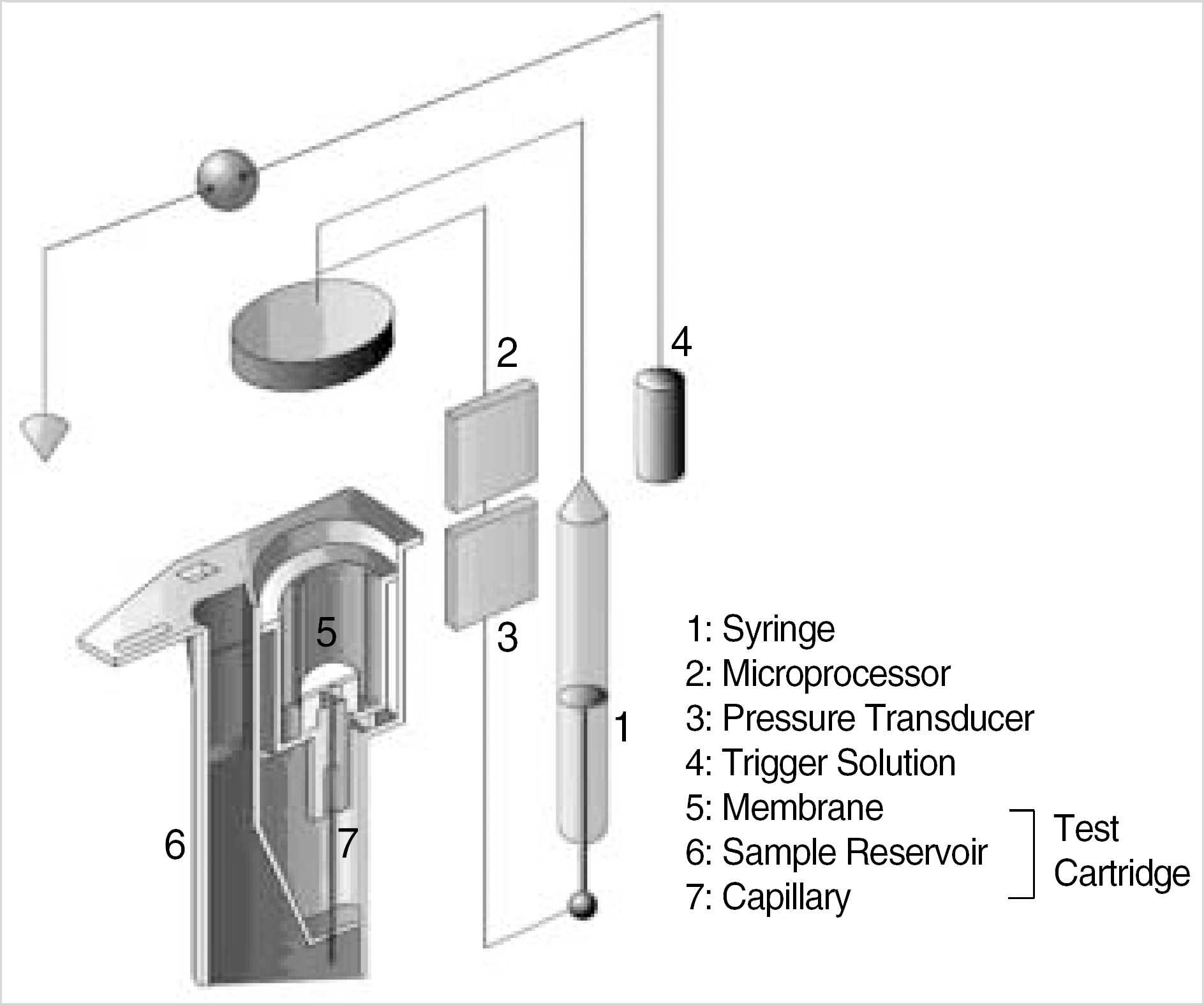Abstract
Background
Platelet Function Analyzer-100 (PFA-100, Dade-Behring, Germany) is an instrument that simulates in vivo hemostatic plug formation under high shear flow by measuring the time required to occlude aperture. We performed this study to reconfirm preanalytical variables and establish the reference intervals of Korean adults.
Methods
A total of 120 healthy individuals were enrolled. Closure times (CT) with the collagen/epinephrine (CEPI) and the collagen/ADP (CADP) cartridges were measured.
Results
The reference intervals by the central 95th percentile were 82-182 sec for CEPI-CT and 62-109 sec for CADP-CT. Females had significantly longer CEPI- and CADP-CT than males (P=0.034 and 0.022, respectively). Individuals over 40 yr showed shorter CEPI- and CADP-CT compared with younger ones (P=0.002 and 0.003, respectively). CEPI- and CADP-CT values measured in the afternoon were significantly longer than corresponding ones in the morning (P<0.0001 in both conditions). Group O blood groups were related to longer CEPI- and CADP-CT compared with non-O blood groups (P=0.0003 and <0.0001, respectively). CADP-CT was weakly correlated with hematocrit (r=-0.296, P=0.001), but not CEPI-CT.
REFERENCES
2.Jilma B. Platelet function analyzer (PFA-100): a tool to quantify congenital or acquired platelet dysfunction. J Lab Clin Med. 2001. 138:152–63.

3.Harrison P. The role of PFA-100 testing in the investigation and management of haemostatic defects in children and adults. Br J Haematol. 2005. 130:3–10.
4.Böck M., de Haan J., Beck KH., Gutensohn K., Hertfelder HJ., Karger R, et al. Standardization of the PFA-100 (R) platelet function test in 105 mmol/l buffered citrate: effect of gender, smoking, and oral contraceptives. Br J Haematol. 1999. 106:898–904.
5.Haubelt H., Anders C., Vogt A., Hoerdt P., Seyfert UT., Hellstern P. Variables influencing Platelet Function Analyzer-100 closure times in healthy individuals. Br J Haematol. 2005. 130:759–67.
6.Suzuki S., Morishita S. The relationship between the onset of labor mechanisms and the hemostatic system. Immunopharmacology. 1999. 43:133–40.

7.Miller JL., Rao AK. Blood platelets and von Willebrand disease. McPherson RA, editor. Clinical diagnosis and management by laboratory methods. 21st ed.Philadelphia: WB Saunders;2007. p. 764.

8.Cariappa R., Wilhite TR., Parvin CA., Luchtman-Jones L. Comparison of PFA-100 and bleeding time testing in pediatric patients with suspected hemorrhagic problems. J Pediatr Hematol Oncol. 2003. 25:474–9.

9.Sestito A., Sciahbasi A., Landolfi R., Maseri A., Lanza GA., Andreotti F. A simple assay for platelet-mediated hemostasis in flowing whole blood (PFA-100): reproducibility and effects of sex and age. Cardiologia. 1999. 44:661–5.
10.Veyradier A., Fressinaud E., Boyer-Neumann C., Trossaert M., Meyer D. von Willebrand factor ristocetin cofactor activity correlates with platelet function in a high shear stress system. Thromb Haemost. 2000. 84:727–8.

11.Jilma-Stohlawetz P., Hergovich N., Homoncik M., Dzirlo L., Horvath M., Janisiw M, et al. Impaired platelet function among platelet donors. Thromb Haemost. 2001. 86:880–6.

12.Nitu-Whalley IC., Lee CA., Hermans C. Reassessment of the correlation between the von Willebrand factor activity, the PFA-100, and the bleeding time in patients with von Willebrand disease. Thromb Haemost. 2001. 86:715–6.

13.Gill JC., Endres-Brooks J., Bauer PJ., Marks WJ Jr., Montgomery RR. The effect of ABO blood group on the diagnosis of von Willebrand disease. Blood. 1987. 69:1691–5.

14.Favaloro EJ., Soltani S., McDonald J., Grezchnik E., Easton L., Favaloro JW. Reassessment of ABO blood group, sex, and age on laboratory parameters used to diagnose von Willebrand disorder: potential influence on the diagnosis vs the potential association with risk of thrombosis. Am J Clin Pathol. 2005. 124:910–7.
15.Dalby MC., Davidson SJ., Burman JF., Davies SW. Diurnal variation in platelet aggregation with the PFA-100 platelet function analyser. Platelets. 2000. 11:320–4.

16.Brezinski DA., Tofler GH., Muller JE., Pohjola-Sintonen S., Willich SN., Schafer AI, et al. Morning increase in platelet aggregability. Association with assumption of the upright posture. Circulation. 1988. 78:35–40.

17.Bridges AB., McLaren M., Scott NA., Pringle TH., McNeill GP., Belch JJ. Circadian variation of tissue plasminogen activator and its inhibitor, von Willebrand factor antigen, and prostacyclin stimulating factor in men with ischaemic heart disease. Br Heart J. 1993. 69:121–4.

18.Rudnicka AR., Rumley A., Lowe GD., Strachan DP. Diurnal, seasonal, and blood-processing patterns in levels of circulating fibrinogen, fibrin D-dimer, C-reactive protein, tissue plasminogen activator, and von Willebrand factor in a 45-year-old population. Circulation. 2007. 115:996–1003.

19.Moeller A., Weippert-Kretschmer M., Prinz H., Kretschmer V. Influence of ABO blood groups on primary hemostasis. Transfusion. 2001. 41:56–60.

20.Lippi G., Franchini M., Brocco G., Manzato F. Influence of the ABO blood type on the platelet function analyzer PFA-100. Thromb Haemost. 2001. 85:369–70.

21.Harrison P., Robinson MS., Mackie IJ., Joseph J., McDonald SJ., Liesner R, et al. Performance of the platelet function analyzer PFA-100 in testing abnormalities of primary haemostasis. Blood Coagul Fibrinolysis. 1999. 10:25–31.
22.Ortel TL., James AH., Thames EH., Moore KD., Greenberg CS. Assessment of primary hemostasis by PFA-100 analysis in a tertiary care center. Thromb Haemost. 2000. 84:93–7.

23.Eugster M., Reinhart WH. The influence of the haematocrit on primary haemostasis in vitro. Thromb Haemost. 2005. 94:1213–8.
24.Han KS., Park MH., Cho HI. Blood groups. Han KS, editor. Transfusion medicine. 3rd ed.Seoul: Korea Medical Book Publisher;2006. p. 205. (한규섭, 박명희, 조한익. 혈액형. In: 한규섭 등. 수혈의학. 제3판, 서울: 고려의학 2006 205.).
25.Heilmann EJ., Kundu SK., Sio R., Garcia C., Gomez R., Christie DJ. Comparison of four commercial citrate blood collection systems for platelet function analysis by the PFA-100 system. Thromb Res. 1997. 87:159–64.
Fig. 1.
Schematic diagram of the mechanism of the platelet function analyzer-100 (from the operating manual of platelet function analyzer-100).

Fig. 2.
Distribution of closure time values determined in the morning tested with the collagen/epinephrine (A) and the collagen/ADP (B) cartridge. The reference intervals (central 95 percentile) are 82-182 sec for collagen/epinephrine and 62-109 sec for collagen/ADP.

Fig. 3.
Linear regression analysis revealed an inverse correlation between age and CEPI-CT (A) and between hematocrit and CADP-CT (B).

Table 1.
PFA-100 closure times according to gender, age, blood type, and sampling time




 PDF
PDF ePub
ePub Citation
Citation Print
Print


 XML Download
XML Download